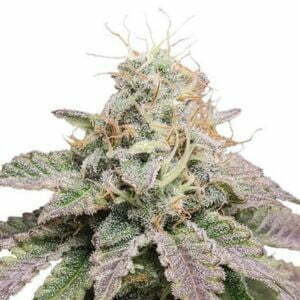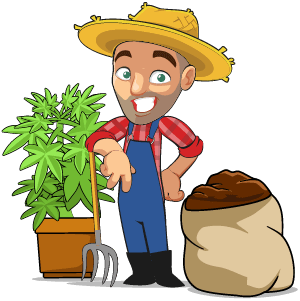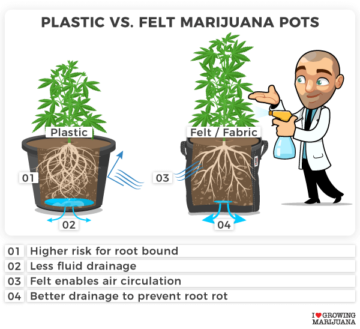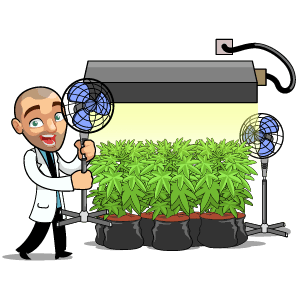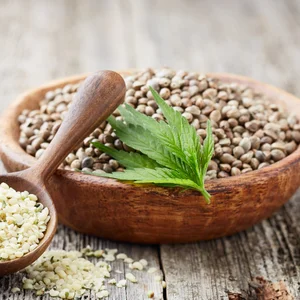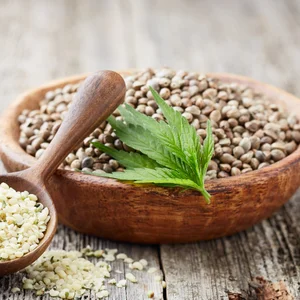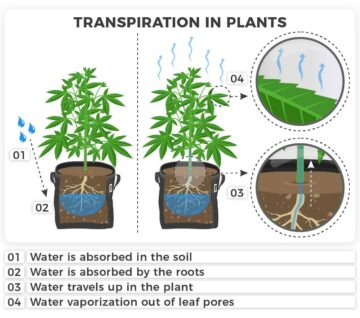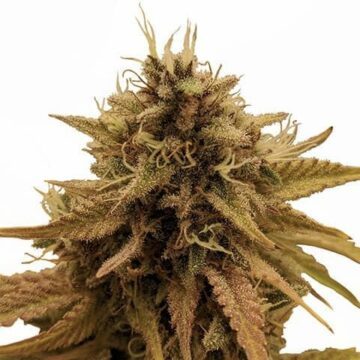So you have a basement and a dream. What’s next?
When people think of home growing, they immediately jump to growing in a closet or a tent. While that’s feasible and possible, those with space in their basement might want to make the most of it.
Although it can be rewarding, building a grow room in a basement takes a lot of thinking about the equipment you’ll need and the environment you want to create for your plants. Basement grow rooms can allow for enhanced security and easier light control. However, the downsides include humidity and cleanliness issues and infrastructure problems.
Are you curious about building a basement grow room? We’ll walk you through the good, the bad, and the different considerations to remember.
The pros and cons of growing cannabis in your basement
Upsides of growing cannabis in your basement
Growing weed in a basement lends itself to many upsides concerning traditional worries about cultivation, such as stealth, ventilation, light control, and pest management.
Regarding stealth and security, a big worry with growing at home involves people smelling and hearing your grow. A basement grow provides odor control and noise reduction by being directly underneath your home. With suppressed odor and noise, the likelihood of anyone detecting your grow or attempting to steal your crop is significantly reduced.
Environmental control is a massive and essential part of making the most of your grow from a plant health and yield standpoint. Basements tend to run cool and damp, both of which are usually a problem when it comes to cannabis, but with the proper preparation, you can make this an advantage. Dehumidifiers and heat mats will be your friends in cool, damp environments. Cool temperatures from the floor can stunt root development, and moist environments make a hospitable environment for pathogens like powdery mildew.
Another beneficial aspect of growing weed in a basement is that basements typically don’t have windows. This simple fact significantly reduces the possibility of light leaking into the room and messing up your veg or flower cycles by shocking your plants in their night periods.
Downsides of basement cannabis cultivation
Considering the challenges and inherent issues you’ll face with using your basement for an indoor grow room is just as important as considering the benefits. Again, basements often have more moisture, making them susceptible to mold and bacteria growth. Use fans to circulate the air and dehumidifiers to control the extra dampness. It’s essential to keep fresh air and prevent harmful matter from growing on your indoor cannabis plants.
You need to address infrastructure challenges to make a proper grow space out of your basement. Unfortunately, establishing adequate water supply, electrical outlets, and heat sources can be demanding. However, overcoming these challenges is essential to provide indoor cannabis plants with the resources for healthy growth.
Unlike a traditional indoor grow room, basement grow rooms tend to be cooler, which can slow down plant growth and cause a shock to your roots. To build a DIY grow room under your house, you must optimize your plant’s climate to produce high yields and top quality. You’ll also need to consider how to make it warmer in your basement, like using heaters or considering the type of light you use – such as whether or not it generates heat.
If you want to read the basics about starting your grow, please sign up below to receive our grow bible and weekly grow tips and seed deals!
Designing and building a grow room in your basement
Basement grow room design can be separated into equipment and infrastructure. Sure, equipment planning is necessary for any grow space, but you’ll need to take special considerations when dealing with a basement environment.
When you build a grow room, the most prominent points to consider for basements are ventilation and humidity. The best way to maintain these two growth pillars is with dehumidifiers, fans, and filters.
Dehumidifiers, fans, and filters will help keep your space optimal and your plants happy— Especially the carbon filter, which can help keep most of the odor inside your weed grow room. Most other concerns for the room are infrastructure-based and centered around prepping and sealing your room.
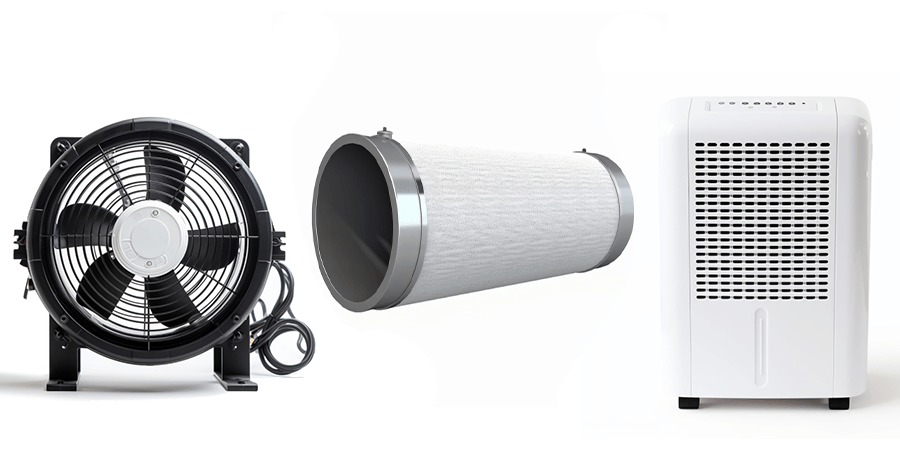

CO2 enrichment for your basement grow room
Additional growth supplementations are a typical consideration when growing cannabis. CO2 is a perfect solution for boosting your plant’s growth. It also helps boost your plant’s photosynthesis process. You can use CO2 in a basement grow. Ensure you maintain proper ventilation around your room when supplementing CO2 and keep your ppm between 1000-1500.
Proper climate control and ventilation are key for a basement grow
Basement grow room ventilation will be a top priority for your grow room. Basements are typically deep underground and sealed to separate the environment from the floors above them or areas like closets. To encourage good ventilation, consider placing fans in different regions of the room. This helps keep your canopy from dead zones that make the perfect environment for pathogens. Aside from pathogens and pests, having fresh air move through your canopy helps encourage the growth of stronger branches.
Have a separate space for the vegetative and flowering stage
A basement grow room can be set up in a few different ways. You can set up a multi-room basement into separate flower and veg rooms, or you can veg or flower simultaneously in a single-room basement.
Tents are another option for creating different environments for veg and flower plants in the same room. Even if you’re using two separate rooms, ensuring they’re sealed off is essential. Remember, each cycle has specific light requirements, leading to the potential of causing veg plants to pre-flower by exposing them to too much light.
Make the most of any available space, but if you want to grow plants in both their veg and flower stages, it’s smart to keep them in separate spaces. Here’s why: having different areas to grow your veg and flower plants lets you do “perpetual” growing. That might sound like a fancy term, but it isn’t all that complicated.
Here’s how perpetual growing works: In one portion of the grow room, you’ll grow veg plants to the size you’re comfortable with before transferring them to a grow tent where they’ll flower. Once those veg plants are out of that space, you’ll replace them with new veg plants that will grow at the same time as your flowering plants.
As your veg and flower plants grow, you’ll begin harvesting your flowering plants and hanging them up to dry. As you pull these plants down, you can transfer your vegging plants to the flower tent and start the cycle over again. This flow ensures that you constantly have flowering plants to harvest and continuous product coming in.
The importance of a clean environment when doing a basement grow
When it comes to the environment of your basement grow room, it’s imperative to consider the cleanliness of your basement as well as your ability to ensure your grow is as pest and pathogen-resistant as possible.
Contamination can happen quickly if you don’t efficiently clean your space and supplies. Mold, heavy metals, and other bacteria can form and pose significant risks to your growing marijuana plants.
If you’re planning to grow in tents, clean both the inside and outside of your grow tent with a mixture of one part 30% hydrogen peroxide and one part water. This mix ensures it’s strong enough to kill pathogens and light enough not to harm your plants or your body, should you get it on your eyes or skin. Safety is a priority!
Another aspect of keeping a clean environment is ensuring you minimize the possibility of bacteria and pests by using an Integrated Pest Management plan. If left unchecked, you can attract mites, fungus, mildew, and other preventable ailments to your plant, but not if you have the right plan! Need supplies? ILGM makes a line of tailored preventative feed solutions to keep your plant safe against threats.
Check out Robert’s Plant Protector series for your IPM needs!


Bergman’s Plant Protector
- Protect your plants from diseases and harmful pests.
- Consists of three 20 ml bottles
- Enough plant protection system supplies for up to 20 plants
- Suitable for soil, hydroponic and all other grow mediums
Final thoughts on basement cannabis cultivation
Embarking on a basement cannabis cultivation adventure offers opportunities and challenges. The advantages include enhanced security, precise light control, and potential stealth. The challenges are the environment.
While dampness in basements can be a concern, you can mitigate it with tools like dehumidifiers and heat mats. Excess moisture invites mold and bacterial growth; adequate ventilation and dehumidifiers help maintain a healthy growing atmosphere.
Crafting an efficient basement grow space requires meticulous planning of equipment and infrastructure. Addressing infrastructure needs, such as water supply and proper heat sources, is fundamental for a successful setup. Prioritizing ventilation, humidity control, and cleanliness is also essential.
Your basement can evolve into a thriving environment for cannabis, provided you embrace safety, hygiene, and climate control. Have more questions about growing indoors? This article is part of a comprehensive series on optimal indoor cannabis cultivation.
Happy growing!
- SEO Powered Content & PR Distribution. Get Amplified Today.
- PlatoData.Network Vertical Generative Ai. Empower Yourself. Access Here.
- PlatoAiStream. Web3 Intelligence. Knowledge Amplified. Access Here.
- PlatoESG. Carbon, CleanTech, Energy, Environment, Solar, Waste Management. Access Here.
- PlatoHealth. Biotech and Clinical Trials Intelligence. Access Here.
- Source: https://www.ilovegrowingmarijuana.com/growing/indoors/basement-grow-room-tips/
- :has
- :is
- :not
- :where
- $UP
- 1
- 20
- 500
- 7
- a
- ability
- About
- above
- address
- addressing
- ADvantage
- advantages
- Adventure
- again
- against
- Against Threats
- AIR
- All
- allow
- also
- an
- and
- and infrastructure
- Another
- any
- anyone
- ARE
- areas
- around
- article
- AS
- aside
- aspect
- At
- Atmosphere
- attempting
- attract
- available
- Bacteria
- Bad
- Basics
- BE
- before
- begin
- being
- below
- beneficial
- benefits
- BEST
- Better
- between
- Big
- body
- boost
- boosting
- both
- branches
- build
- Building
- but
- by
- CAN
- cannabis
- Canopy
- carbon
- Cause
- causing
- centered
- challenges
- Climate
- co2
- comes
- comfortable
- coming
- complicated
- comprehensive
- Concern
- concerning
- Concerns
- Cons
- Consider
- consideration
- considerations
- considering
- constantly
- continuous
- control
- Cool
- create
- Creating
- crop
- cultivation
- curious
- cycle
- cycles
- dead
- dealing
- deep
- demanding
- Design
- Development
- different
- directly
- diseases
- Diy
- do
- doing
- Dont
- down
- downsides
- dream
- each
- easier
- efficient
- efficiently
- embrace
- encourage
- enhanced
- enough
- ensure
- ensures
- ensuring
- Environment
- environments
- equipment
- especially
- essential
- establishing
- Ether (ETH)
- Even
- evolve
- excess
- extra
- Eyes
- Face
- fact
- fan
- fans
- feasible
- few
- filter
- filters
- Floor
- floors
- flow
- flower
- For
- form
- fresh
- friends
- from
- fundamental
- generates
- get
- good
- Grow
- Grow Tips
- Growing
- Growth
- happen
- harm
- harmful
- Harvesting
- Have
- having
- Health
- healthy
- hearing
- heavy
- help
- helps
- High
- Home
- House
- How
- How To
- However
- HTTPS
- hydrogen
- hydroponic
- if
- immediately
- imperative
- importance
- important
- in
- include
- Indoor
- Infrastructure
- inherent
- inside
- integrated
- into
- Invest
- invites
- involves
- issues
- IT
- itself
- jump
- just
- Keep
- keeping
- Key
- Kill
- leading
- left
- Lets
- light
- like
- likelihood
- Line
- Lot
- maintain
- make
- MAKES
- Making
- management
- many
- marijuana
- massive
- Matter
- max-width
- Metals
- meticulous
- might
- minimize
- Mitigate
- mix
- mixture
- ML
- more
- most
- move
- much
- must
- necessary
- Need
- needs
- New
- next
- night
- Noise
- of
- off
- Offers
- often
- on
- once
- ONE
- opportunities
- optimal
- Option
- or
- Other
- our
- out
- Outlets
- outside
- over
- overcoming
- part
- People
- perfect
- periods
- Perpetual
- Photosynthesis
- pieces
- pillars
- placing
- planning
- plant
- plants
- plato
- Plato Data Intelligence
- PlatoData
- please
- points
- pose
- possibility
- possible
- potential
- precise
- preparation
- prevent
- prioritizing
- priority
- Problem
- problems
- process
- produce
- Product
- prominent
- proper
- PROS
- protection
- provide
- provided
- provides
- quality
- Questions
- quickly
- Read
- receive
- Reduced
- reduces
- reduction
- regions
- remember
- replace
- Requirements
- requires
- Resources
- rewarding
- right
- risks
- Room
- Rooms
- root
- roots
- Run
- safe
- Safety
- same
- security
- seed
- separate
- Series
- set
- setup
- should
- sign
- significant
- significantly
- Simple
- simultaneously
- Size
- Skin
- slow
- smart
- soil
- solution
- Solutions
- Sound
- Sources
- Space
- spaces
- special
- specific
- stages
- standpoint
- start
- Starting
- Stealth
- strong
- stronger
- successful
- such
- supply
- sure
- susceptible
- system
- tailored
- Take
- takes
- tent
- term
- that
- The
- The Basics
- their
- Them
- These
- they
- Think
- Thinking
- this
- those
- threats
- three
- thriving
- thriving environment
- Through
- time
- tips
- Title
- to
- too
- tools
- top
- traditional
- transfer
- Transferring
- two
- type
- typical
- typically
- under
- underneath
- unfortunately
- use
- using
- usually
- walk
- want
- Warmer
- Water
- Way..
- ways
- weed
- weekly
- WELL
- when
- whether
- which
- while
- why
- will
- windows
- with
- works
- worry
- Yield
- yields
- you
- Your
- zephyrnet
- zones


